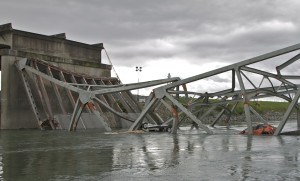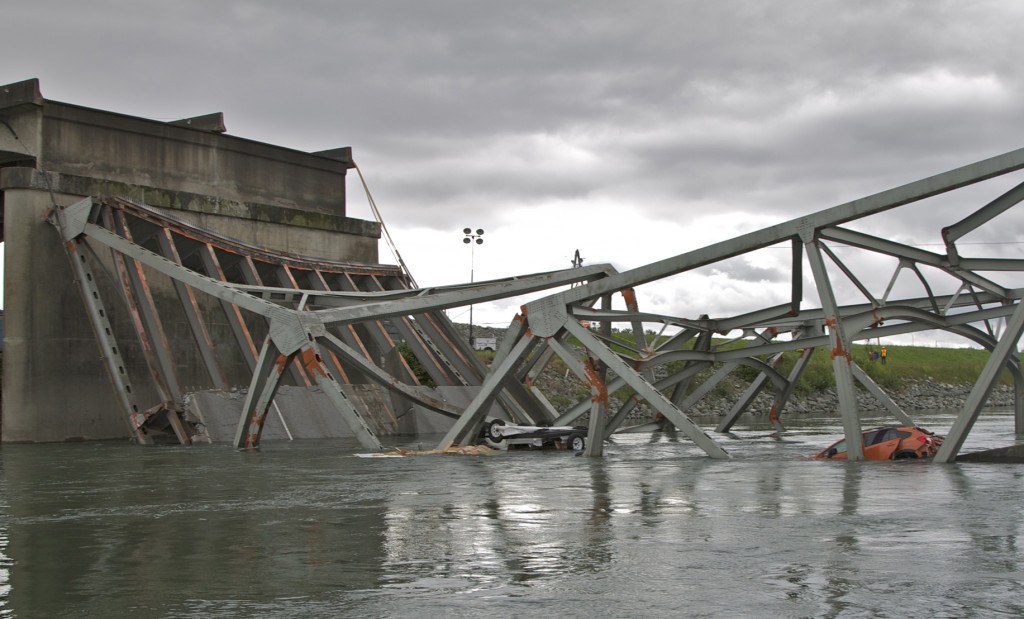Insufficient route planning, a distracted pilot driver and an inadequate permitting process by the state of Washington all played a part in last year’s Interstate 5 bridge collapse north of Seattle, which sent two cars into a river below, the National Transportation Safety Board said Tuesday.
The board voted unanimously after a nearly two-hour hearing to issue a number of recommendations, including encouraging states to ban nonessential cellphone use by pilot car drivers and requiring better warnings of low-clearance bridges, as well as lane-specific guidance for bridge clearance.

Chris Hart, acting chairman of the four-member board, said the wide-ranging report provided by NTSB staff showed the “many missed opportunities to prevent this accident.”
“Movement of oversized loads is a specialized operation that demands special precautions,” he said. “What this investigation uncovered were multiple gaps in multiple systems.”
Board member Mark Rosekind said the report showed “there were holes in every one of these slices of cheese.”
A section of the bridge fell into the water in May 2013 after a truck carrying a tall load hit the bridge in Mount Vernon, about 60 miles north of Seattle. Two other vehicles fell into the Skagit River, and three people were rescued with minor injuries.
William Scott, who was driving the truck with the tall load for Mullen Trucking, told investigators a freight truck came up fast on his left. He said he drove to the bridge’s right side, which had a lower vertical clearance than the center lane.
According to the investigation, Scott thought his load was 15 feet, 9 inches – about 2 inches shorter than it actually was. The top of the load collided with the far right side of the overhead truss structure.
The state Department of Transportation automatically issued Mullen Trucking an oversize-load permit over the Internet, without personnel review and without comparing the given dimensions to the proposed route, according to Tuesday’s staff presentation.
NTSB staff noted an automatic permit process does not motivate carriers to conduct route surveys ahead of time to ensure their loads are within the clearance limits.
The pilot vehicle’s driver, Tammy Detray, told investigators the clearance pole mounted on her vehicle never struck the bridge. She also said she was using her cellphone on a hands-free device at the time of the accident.
“Her entire reason for being there was to protect the oversize vehicle and the vehicles that shared the roadway with her, and yet she jeopardized the safety of others because of a cellphone call,” board member Robert Sumwalt said.
Sumwalt asked staff whether the accident could have been avoided if Detray had notified Scott of the low clearance. He was told Scott was following Detray too closely to stop safely.
The investigation showed Scott was about 400 feet, or about five seconds, behind the pilot car, instead of the 865 feet, or 10 seconds, he should have been trailing by.
Safety recommendations also approved by the board include asking the Federal Highway Administration to develop a guide for states on how to prevent bridge strikes, including collecting and sharing data, and evaluating and reviewing bridge strike countermeasures.
In a written statement, state Department of Transportation Secretary Lynn Peterson said the agency already has started working on improving access to data for the freight industry, and would work with the industry and Legislature for any recommendations that require legislative action.
“We all aim to provide the safest conditions possible for the traveling public,” she wrote.
As for the other changes, including to the permitting process oversight, spokesman Lars Erickson said the department will move on making revisions. “That’s our commitment,” he said.
The 59-year-old Skagit bridge carries an average of 71,000 vehicles a day over the river on I-5, Washington’s major north-south roadway between Oregon and Canada. Workers installed an emergency span and then replaced it with a permanent one in September.
Was this article valuable?
Here are more articles you may enjoy.


 Hedge Funds Are Hunting Deals in Risks Too Big for Insurers
Hedge Funds Are Hunting Deals in Risks Too Big for Insurers  ‘Everything Is on the Table’ in NYC Helicopter Probe, NTSB Says
‘Everything Is on the Table’ in NYC Helicopter Probe, NTSB Says  LA Wildfires Had Little Impact on Reinsurer Risk Appetite During April Renewals
LA Wildfires Had Little Impact on Reinsurer Risk Appetite During April Renewals  Insurance Industry Contemplates Knock-On Effect of Tariffs to Claims, Consumers
Insurance Industry Contemplates Knock-On Effect of Tariffs to Claims, Consumers 